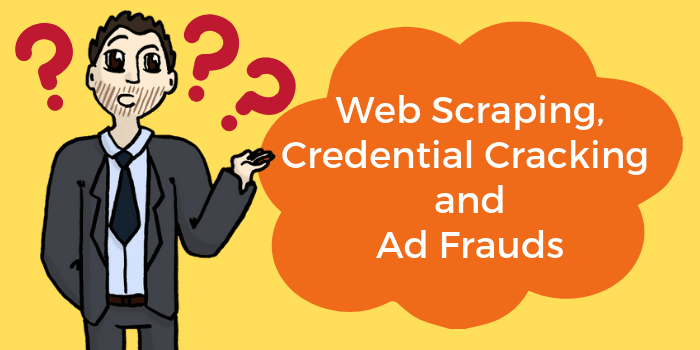I'm not an internet security expert, in fact, I know very little about it. But one thing I would avoid is to trust unknown web sources. To simply put, if I see new software, a plugin that looks like it does a good job, or any file that appears to be good to use on a website, I always google it first. If nothing comes up in Google search, then I'll stay away. It may sound extremely obvious to you, but developers continuously create the world's most innovating stuff, and a lot of which seem so inviting and real. I'm very tempted to give them a try, but I never know the consequences. A lot of the seemingly "innovative" software can be too good to be true. In fact, they can harm your website and business.

Did You Know?
- Web Scraping Incidents: 90% of large organizations report having their data scraped from their websites in 2022.
- Credential Cracking Attempts: Over 80% of cyberattacks involve brute force or the use of lost or stolen credentials.
- Ad Fraud Losses: Global losses from ad fraud are projected to hit $44 billion annually by 2022.
- Bot Traffic: Approximately 24% of internet traffic in 2021 was attributed to malicious bots involved in web scraping.
- Credential Stuffing: Credential stuffing accounts for 30% of all login attempts for online services.
Scary Scripts
Importing third-party scripts, for example. A few years ago, I witnessed my friend importing a game script to his site and damaged his entire website. He got the script from someone he knew from a developers' forum. Unfortunately, the person who gave him the script disappeared shortly after the incident.
It may seem like a cool thing to add something unusual to your website and provide an enhanced experience to the visitors. However, you should also have a little bit of understanding of the harmful effects that scripts can create on websites. Then you will be able to take appropriate measures to overcome the negative consequences that you have to face in the future.
Even non-cybersecurity specialists like you and I know that there is a countless number of malware exist to create a negative impact on the security of your website. If you have an old plugin or script from a third-party up and running in your website or have a landing page template purchased from an untrusted source, you should pay particular attention to these factors. Then you will be able to take appropriate steps to overcome the adverse effects that you may experience.
Did You Know?
- Impact on E-commerce: About 97% of businesses in the e-commerce sector are affected by web scraping.
- Security Measures: Only 40% of businesses have tools in place to detect and prevent web scraping.
- Financial Sector Attacks: The financial sector reports an average of 3,500 credential stuffing attacks per day.
- Fake Ad Impressions: Nearly 20% of all digital ad impressions are estimated to be fraudulent.
- Cost of Credential Cracking: Credential cracking costs businesses an average of $6 million annually in mitigation and lost revenue.
Web Scraping
"Web scrapers" are able to steal the content of your site and display it illicitly on other websites. If you don’t do your own research, you will never be able to identify that the content on your website has been scraped.
When the content of your website is duplicated, you will have to end up with poor search engine rankings. As a result, you will only get a reduced number of visitors to your website. This can create a significant impact on your sales at the end of the day.
You need to keep in mind that your malicious competitors are using bots to keep an eye on you. Therefore, you should have a clear understanding of how to detect such instances. If you see the exact same content of your website on another website, you can suspect that web scrapers are responsible for it. Even your price changes would make your competitors change their prices rapidly. This is another tell-tale sign that you can use to detect the adverse effects created by scrapers.
Did You Know?
- Data Integrity: 78% of online businesses express concerns that web scraping could distort their analytics or business metrics.
- Mobile Ad Fraud: Mobile ad fraud rate is around 15%, with app install fraud being particularly prevalent.
- Growth of Ad Frauds: Ad fraud in the digital industry grows by about 21% annually.
- Recovery from Credential Cracking: It takes an average of 250 hours for a business to recover from a credential cracking incident.
- ROI on Fraudulent Ads: Fraudsters can earn an estimated $7 for every dollar spent on fraudulent ad campaigns.

Credential Cracking
Credential cracking is a technique used by hackers when they are aware of a known username to log into your website. When they see a username, they just use bots to match a password to gain access to your site. Hackers create a "brute force" cracking software and have it to search for passwords.
In most of the instances, website owners tend to use their email addresses as the username. This makes life easier for hackers to go ahead with credential cracking. You need to be mindful about this when you have some script from unknown source installed on your website as well, as the script can attract those malicious hackers' attention.
The credential cracking bots are intelligent enough to detect the common passwords that people tend to use in their websites. They are quick enough to validate the login credentials within a short period as well. Then they are in a position to go ahead with account takeovers.
You can detect these attempts with careful observation as well. If you notice that there is an unusual rate of failed login attempts on the website, you need to understand that a credential cracking attempt is about to take place. You must also take a look at the user directory as well as the authentication logs to look for such signs.
Did You Know?
- Automated Scraping Tools: Over 50% of web scraping is conducted using sophisticated automated tools.
- Credential Cracking Tools: There are over 1,000 different credential cracking software tools available on the dark web.
- Detection of Ad Frauds: Only 20% of digital marketers feel confident in their ability to detect ad fraud.
- Effect of Bots on Web Traffic: Bots generate up to 40% of total web traffic, complicating efforts to mitigate scraping and fraud.
- Legal Actions: As of 2021, there have been over 150 major legal cases involving web scraping practices.
Ad Frauds
An "Ad Fraud" is performed by dishonest publishers to increase their revenues by generating more ad traffic.
Ad frauds give a negative impact on websites, and the businesses lose a considerable amount of money. Online advertisers always expect that their ads will be able to attract the eyes of visitors. But in reality, their ads are visible to both humans as well as bots. If an advertisement is seen by a bot, there is no positive gain that the advertiser can gain out of it.
In the meantime, the publishers are looking to enhancing the advertisement revenues while increasing the total number of advertisements that they offer as well. In other words, they are only concerned about the CPM charged. When the bots try to take place the place of humans, the serving resources of the advertisements will be drained.
In here, the entire revenue and traffic generated by the advertisements will be directed to the malicious developers who created the fraud bots. This will not just lead the websites towards loss of income, but it can also create a significant impact on the positive reputation.
You will be able to spot these issues with a careful eye as well. If you see there is a steep decline in the volume of conversions, you need to assume that the ad frauds are doing something, especially when there is no change in the keyword bids. The lower user engagement rates is another tell-tale sign that can help you to detect ad frauds. Therefore, you need to pay a lot of attention to this fact and make sure that you don’t end up with any negative consequences.
Conclusion
You can avoid these malicious security threats by staying away from unknown programming sources. If you use WordPress with the latest theme, use only the most recent and popular plugins, and have it hosted by a secure web hosting company, you'll be unlikely to encounter such problems. From time to time, we see some "developers" offer to pay you to test their new software or script code. As much as that kind of invitation can sound tempting, I would advise you not to participate unless you know what you are doing.
